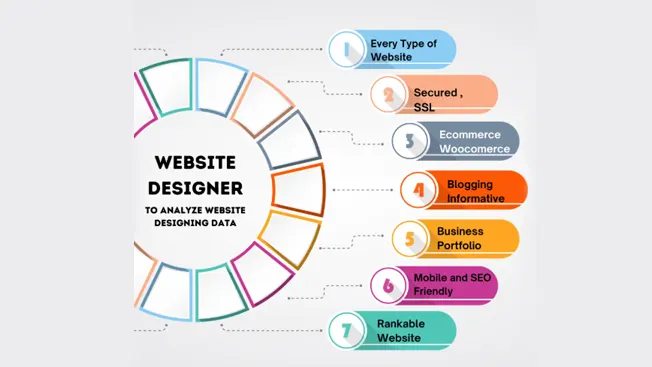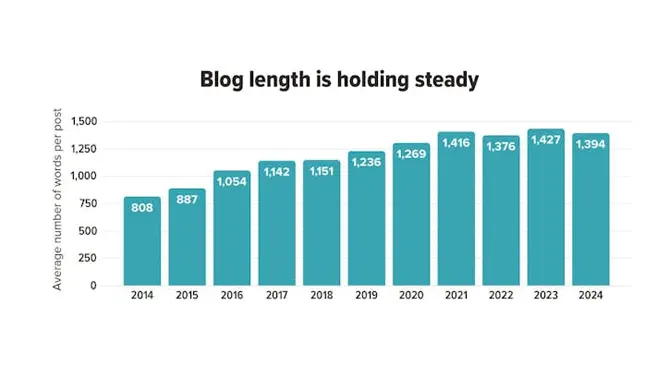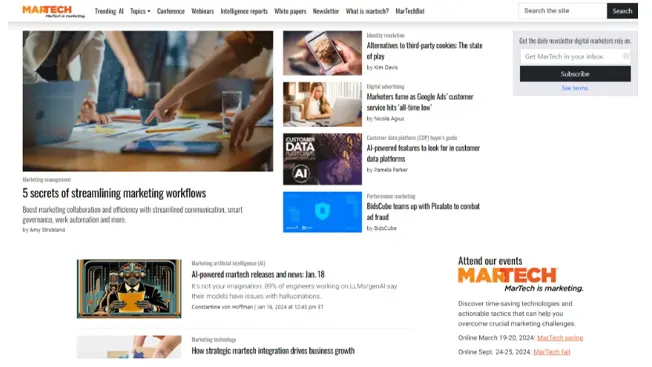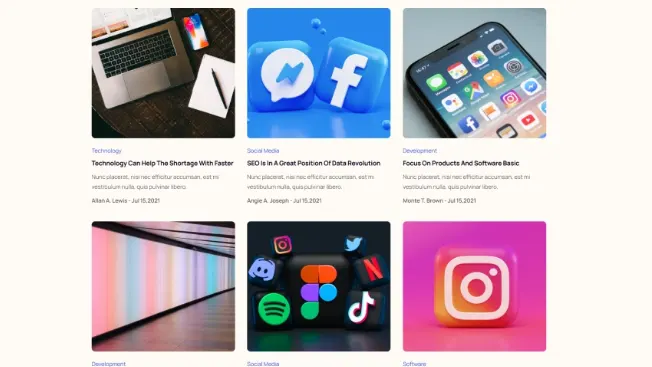
A blog is a potent marketing tool that may increase brand authority, provide leads, and increase organic traffic in addition to serving as a creative outlet.
Starting a blog enables you to engage with your audience, develop thought leadership, and improve SEO rankings, regardless of whether you work as a freelancer or as a member of a marketing team.
However, blogging is becoming more competitive due to the abundance of information available online and ongoing developments in search marketing (like Google’s AI Overviews).
Just creating a blog and posting content is insufficient. Understanding your audience, determining their needs, and using your content to draw in, interact with, and develop them are all essential components of a strategic strategy that will help you stand out.
This post will explain the fundamentals of blogging, offer tips for increasing blog visibility, and provide examples of exceptional blogs.
What we’ll discuss is as follows:
- What is a blog?
- Why write a blog?
- How do I start blogging?
- How to use AI for your blog
- How frequently should I blog?
- What are good topics to blog about?
- How should I promote my blog?
- 4 great blog examples
- 11 tips for writing an effective blog
What is a blog?
A blog is a frequently updated weblog that is used to advertise people or companies.
In order to draw in and keep readers interested, the most prosperous blogs concentrate on specialised subjects. Four niches—food, lifestyle, travel, and arts and crafts—account for 74% of all high-traffic blogs, according to RankIQ.
In addition to social media, marketers use blogs to engage with their audience and create communities. In order to disseminate important information and promote data collection, several companies incorporate blogs into their primary websites.
There are several kinds of blog content to think about. 74% of bloggers publish how-to pieces, 50% make lists, and 46% write manuals or ebooks, according to research by Orbit Media.
These content types are widely used because they offer readers useful solutions to frequent problems, which makes them extremely helpful.


Why write a blog?
It is not appropriate to utilise a blog as a direct sales pitch. Rather, its main objective is to deliver worthwhile, educational information that appeals to readers.
Concentrate on producing excellent, pertinent material that people want to share and find helpful. Make use of your buyer personas to make sure your blog speaks to the needs and interests of your readers and keeps them interested.
Additionally, a well-written blog can benefit marketers:
- Become an industry leader
- Create enduring bonds with your clients
- Boost awareness of a brand, good, or service
- Increase website or landing page traffic
- Draw in and cultivate prospective clients
When starting a blog for yourself or your business, keep in mind that blogging calls for consistency, time, and work.
Thankfully, research, content creation, and maintenance may be streamlined with the use of AI-powered copywriting tools (more on that later).
You must commit time and resources to a number of crucial duties in order to operate a successful blog, such as:
- conducting research, creating, and revising material
- Finding pictures and videos
- Interacting with readers by answering their queries and comments
- Using a variety of platforms to advertise your blog
- Making connections with other bloggers and experts in the field
- Finding and posting guest articles
- Outreaching to obtain high-quality backlinks
- Make sure you’re ready for the continuous commitment that blogging demands before you start one; having the time, commitment, and plan in place will position you for long-term success.
How do I start blogging?
The secret is to keep things simple and take things one step at a time, whether you’re establishing your first blog or giving it another go.
Your blog may be launched in five simple steps:
- Choose a topic
- Name your domain
- Choose a blogging platform
- Choose your hosting and theme
- Plan and write content
For a more thorough explanation of each step’s components, continue reading.
Step 1: Choose a topic
Concentrating on your areas of greatest love is a fantastic method to select a blog topic or theme.
Which topics do you read about or talk about all the time? What interests you enough to write about on a regular basis without getting bored?
For companies, think of your USP, frequently asked consumer queries, or popular industry searches that you may use.
It could be challenging to compete with bigger websites if your topic is too general. Rather, you can improve your odds of success by focussing more narrowly.
For instance, writing about growing roses is more specialised than discussing horticulture in general, and blogging about belly fat reduction is more focused than writing about weight loss in general.
Do not overthink anything if you are not sure where you are headed. Later on, you may always change or improve your topic. Starting and making adjustments as you go is crucial.
Step 2: Choose a domain name
Your blog’s title is your domain name, so pick something that’s simple to spell and remember. Hyphens can make your URL more difficult to type and remember, so stay away from using them.
To increase search exposure, try to include a relevant keyword in your domain name. To find out what your audience is looking for on search engines or social media sites like TikTok, do keyword research.
Several companies, such as NameCheap, Wix, Bluehost, and GoDaddy, offer domain names for sale.
Step 3: Choose a blogging platform
Both free and paid options are available for a variety of blogging platforms and AI-powered website tools.
Although they have drawbacks, free platforms can be a fantastic place to start. You won’t have complete control, and advertisements will appear on your website. One benefit is that you won’t have to buy hosting or a domain name.
A self-hosted, paid platform that offers complete control and customisation possibilities is the superior alternative for enterprises.
The complexity of blogging platforms varies, so it’s critical to select one that complements your degree of expertise and permits expansion and adaptability in the future.
AI integration is now a feature of many contemporary platforms, which improves the efficiency of content administration and creation.
WordPress.org – This self-hosted blogging platform offers a large selection of themes and plugins, robust community support, and a wealth of features.
WordPress.com – This free blogging platform is perfect for new users because it has a low learning curve. You don’t have complete control over your material, though, and it shows advertisements on your website like other free solutions.
Blogger – Another free platform that is ideal for novices who have never blogged before is this one. You don’t own your blog entirely, though, and you have restricted access to tools and support, just like with WordPress.com.
Squarespace – A drag-and-drop website builder makes customisation simple with this user-friendly platform.
Wix – Additionally, this platform has drag-and-drop tools that make creating websites easy and straightforward.
Joomla – Like WordPress.org, this open-source content management system is self-hosted and offers a number of templates, but it lacks community support.
Medium – In addition to helping businesses create a community, this platform is widely considered the finest for authors. It’s easy to use and has a reader recommendation system to help you expand your readership.
Drupal – Drupal is a flexible open-source content management system made for enterprises and experienced users. Because of its broad support for different kinds of content, page templates, and blocks, content management and production are incredibly customisable.
If you decide to use a free platform to get experience, be aware that advertisements may show up on your website and detract from your content.
A self-hosted platform is probably the best option for a professional blog because it gives you complete control and a more polished appearance.
Step 4: Choose your blog host and theme
After deciding on a domain name and hosting provider, you may install a theme and launch your blog. A theme is a template that improves your blog’s appearance.
The majority of blogging platforms include a range of free themes, but for a more personalised appearance, you can also choose to buy a premium theme.
In addition to a vibrant and helpful community for troubleshooting, WordPress offers a wealth of tutorials to walk you through the theme installation process.
For other blogging platforms, assistance with the technical aspects of theme installation should be provided by both the platform and your web hosting company.
WordPress also provides a large selection of plugins to improve the functionality of your blog. Some help with behind-the-scenes management, while others enhance the user experience. You can look for plugins that are specific to your needs, such editorial calendars, picture tools, or contact forms, within the WordPress dashboard.

Yoast SEO, which optimises your site for search engines, and Akismet, which helps prevent comment spam, are two highly recommended plugins for almost all WordPress blog.
Visit the blog “5 Crucial Steps to Boost Your WordPress SEO” for additional advice.
Step 5: Create your content
It’s time to start blogging after your blog is up and running. You may stay organised and plan ahead by using an editorial or content calendar.
Pay attention to what your target audience wants to read. To keep readers interested, produce material that is pertinent to your niche while being focused and captivating.
Using a content pillar method is a terrific tactic. This entails creating central themes that serve as the framework for all of your material.
For instance, you might make a pillar page titled “10 of the Best Restaurants in the World” if your site is about restaurants. After then, supporting material may focus on certain places, such New York, London, or Berlin, all of which would connect to the primary pillar page.
Consistency is crucial, even though blogging every day isn’t required. Creating new material on a regular basis helps you build a devoted following and keeps your audience interested.
Think about planning and draughting posts ahead of time according to periods of high activity to stay ahead of the game.
Your writing will get stronger and you’ll get more adept at figuring out what appeals to your readers as you blog more regularly. Analyse your blog’s performance to see which subjects bring in the most visitors or leads, then adjust your approach accordingly.
How to use AI for your blog
Numerous AI marketing solutions are now accessible to improve your blog, ranging from audience interaction and promotion to content production and SEO optimisation.
Time-consuming activities can be handled by AI, freeing you up to concentrate on the strategic and creative elements of your content.
Think about using AI writing assistants for content development, such as ChatGPT, Claude, or Perplexity. Google Notebook LM can also be used to find content gaps and make suggestions for enhancements.
Watch this tutorial to learn how to use Google Notebook LM for more effective content refinement.
Artificial intelligence (AI)-powered programs such as SurferSEO and Clearscope may analyse high-ranking material, recommend keywords, create meta descriptions and titles, and assist in properly structuring your posts to optimise your blog for search engines.
AI may also improve personalisation through the creation of dynamic content, chatbots that interact with users, and AI-driven recommendations that make related post suggestions based on user behaviour.
Tools such as Midjourney and DALL·E can produce high-quality photos for visuals and multimedia to improve your content.
Hemingway and Grammarly enhance readability in editing and proofreading, whereas Turnitin and Copyscape assist in identifying plagiarism.
Try adding some AI tools to your workflow if you don’t currently have them. Knowing how to use AI can help you advance your profession and streamline your marketing efforts.
How frequently should I blog?
The straightforward response is: whenever feasible! Nonetheless, quality should always come before quantity.
The typical blog article is 1,400 words long and takes about three hours and forty-eight minutes to compose, according to Orbit Media.

Because it enables a thorough exploration of a topic and offers readers genuine value, this length is referred described as the “sweet spot.”
Make an effort to cover themes as thoroughly as you can; one well-researched blog post every month or every two weeks works much better than several mediocre ones every week.
Your information will be soon forgotten and unlikely to be shared if it doesn’t provide something interesting or helpful.
Reviewing and updating previous content is also crucial, particularly for items that have performed well. To determine what needs to be updated, do a content audit. This might be as easy as adding new images or videos, updating out-of-date data and links, or enlarging parts to reflect current trends.
“The mere fact that you have produced content does not guarantee its success. According to Luke O’Leary, Vice President of Media Strategy & Operations at NP Digital, in our 2025 trends blog, “You have to constantly revitalise pieces—either by adding new information to keep them fresh or by evolving them as the behaviour of the web changes.”
What are good topics to blog about?
The options for blog subjects are virtually limitless. Put yourself in your reader’s position to determine the best one; think about what they find valuable, interesting, and attention-grabbing.
The blogs that are the most successful:
Share valuable and insightful information
Offer a fresh and unique perspective
Establish your expertise and credibility
Align with search intent on search engines and social media
Engage and connect with your readers authentically
Good topics for a blog include:
Share an inspiring success story
Provide a detailed answer to a common customer question
Highlight a fun or humorous way someone used your product or service
Showcase a case study or customer testimonial relevant to your industry
Feature an interview with an industry expert
Create engaging how-to guides or listicles
Offer a walkthrough video with supporting written content
Explore emerging and future trends in your industry
Discuss topics related to personal development and growth
How should I promote my blog?
Ultimately, your objective is to reach as many people as you can with your blog.
The secret to doing this is to continuously produce original, high-quality content that people value, anticipate, and want to share.
But having excellent content isn’t enough; you also need to aggressively market it! Thankfully, there are several methods for doing this:
- Post a link to your blog on social network, or turn it into a carousel or other brief content.
- Distribute it to your subscribers or, better yet, your email list.
- Make a newsletter to disseminate your material and cultivate a loyal following.
- Collaborate with influencers to increase your visibility.
- Use guest authors to cross-promote material and offer new viewpoints.
- Make use of sponsored advertising, such as social media or Google Ads.
- Transform your blog into a video and post it to YouTube.
- Post on Reddit and other pertinent sites and forums.
Never consider promotion as an afterthought. The return on the time and effort you invest in producing your content increases with the amount of work you put into sharing and distributing it.
Promote extensively, regularly, and intelligently to increase visibility, increase website traffic, and draw in possible new clients.
4 Great Blog Examples
It’s beneficial to look at samples before beginning a blog to gain ideas and a sense of successful headlines and layouts. The following four blogs will help you plan and design your own.
1) Not Another Cooking Show

Through entertaining video material, Stephen Cusato’s food blog, “Not Another Cooking Show,” aims to encourage people to cook with confidence.
He utilises his blog to share recipes and tools, including a pantry stocking guide, and posts weekly YouTube videos on how to prepare delectable meals. He also makes money from his blog by having a store area with branded goods and a cook book.
2) MarTech

Transformation, data, operations, experience, performance, and management are the six main subjects covered by the blog MarTech, which is devoted to the nexus between marketing and technology.
In addition to blog posts, the website provides whitepapers, bulletins, webinars, intelligence reports, and events as tools to help users navigate the marketing funnel.
Every blog post includes an interactive chatbot for reader interaction, social media sharing buttons, and an estimated reading time.
3. The Good Trade

“The Good Trade” is a lifestyle media brand that publishes editorials about self-care, slow living, and sustainability.
In order to provide helpful advice and answers, its site regularly uses listicles and headers that ask questions. In order to connect with its target audience, the imagery is carefully chosen to complement the content, frequently featuring women.
The blog has over 100 million readers, and it reaches a wider audience by sending out a daily newsletter to 250,000 subscribers.
4) The Digital Marketing Institute

It would be impossible to discuss blogs without bringing up our own!
The DMI blog, which was created as a resource for professionals in digital marketing, provides a plethora of material in areas such as social media marketing, PPC & paid search, content marketing, AI in digital marketing, and more, making it simple for users to locate information pertinent to their positions.
Both marketers and students taking our certification courses benefit from the blog’s hundreds of resources, which include case studies, podcasts, on-demand webinars, toolkits, and ebooks.
To keep readers informed of the most recent developments in the business, a “Trending” section showcases content that is popular across all forms and advertises forthcoming marketing events.
11 tips for writing an effective blog
Here’s how you can write engaging and well-crafted blog posts that attract and retain readers:
Plan Before You Write – Outline your blog post to organize your thoughts and ensure a logical flow.
Structure Matters – Include a clear beginning (introduction), middle (main content), and end (conclusion) to guide your readers smoothly.
Keep It Conversational—Write as if you’re chatting with a friend. Use an informal tone, avoid jargon, and keep things simple.
Engage the Reader Directly – Use words like “you,” “we,” and “I” to create a personal connection.
Use Contractions – Keep your writing natural with contractions like “I’m” instead of “I am” and “don’t” instead of “do not.”
Craft a Catchy Headline – Use curiosity-driven or emotional headlines, preferably under eight words. Adding a keyword boosts SEO, and posing a question can intrigue readers (e.g., “Want to Double Your Sales in a Week?”).
Make Content Scannable – Use subheadings, bullet points, and numbered lists to make reading easy. Subheadings (H2, H3) act as signposts for your content.
Add Visuals – Incorporate images and videos to enhance engagement. Consider summarizing key points in a video and expanding on them in writing.
Include Calls-to-Action (CTAs) – Encourage readers to follow you on social media, download a resource, or take another action aligned with your goals.
Encourage Interaction – Ask questions or invite comments to foster engagement. If managing comments is time-consuming, consider disabling them.
Proofread Before Publishing – Ensure your post is free of typos and grammatical errors. Tools like Grammarly can help refine your content.
Supercharge your digital marketing career
Obtaining a digital marketing certification is the quickest and most efficient approach to get started in the digital sector. The foundations of digital marketing are covered in DMI’s industry-aligned Professional Diploma in Digital Marketing, which also teaches you how to use AI into your strategy and build critical soft skills. Additionally, you will become proficient in important fields like social media, SEO, email marketing, content marketing, and display and video advertising, which will enable you to manage effective marketing campaigns in any sector.

